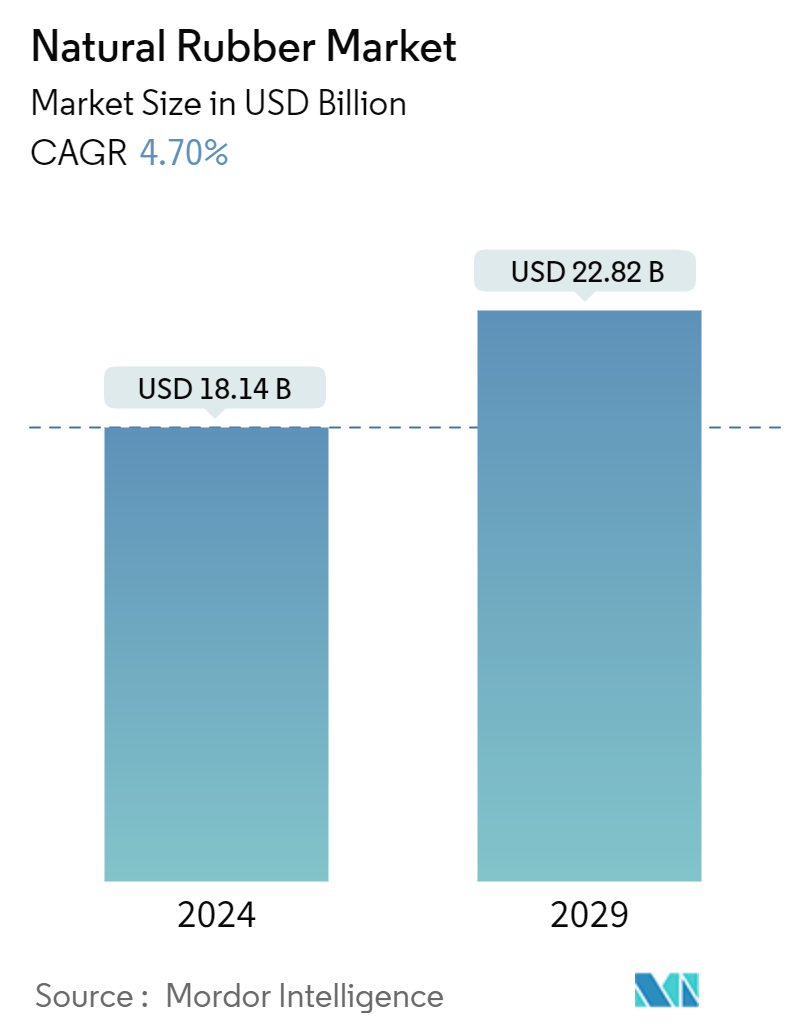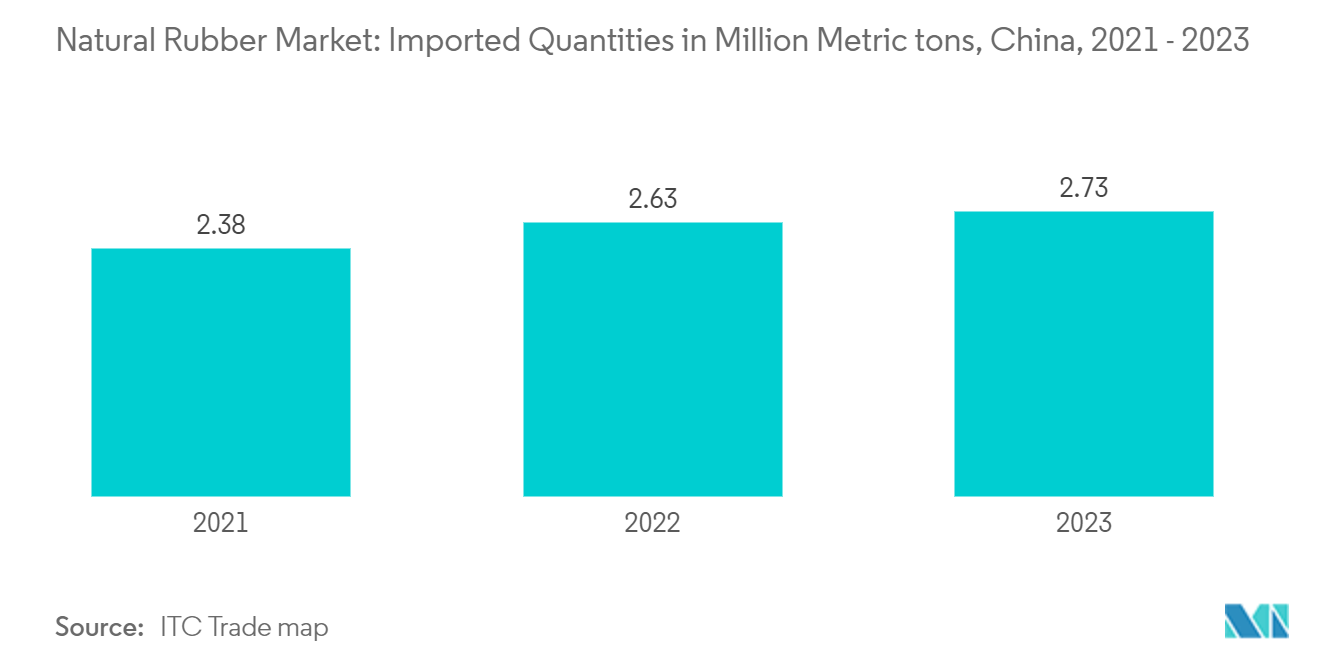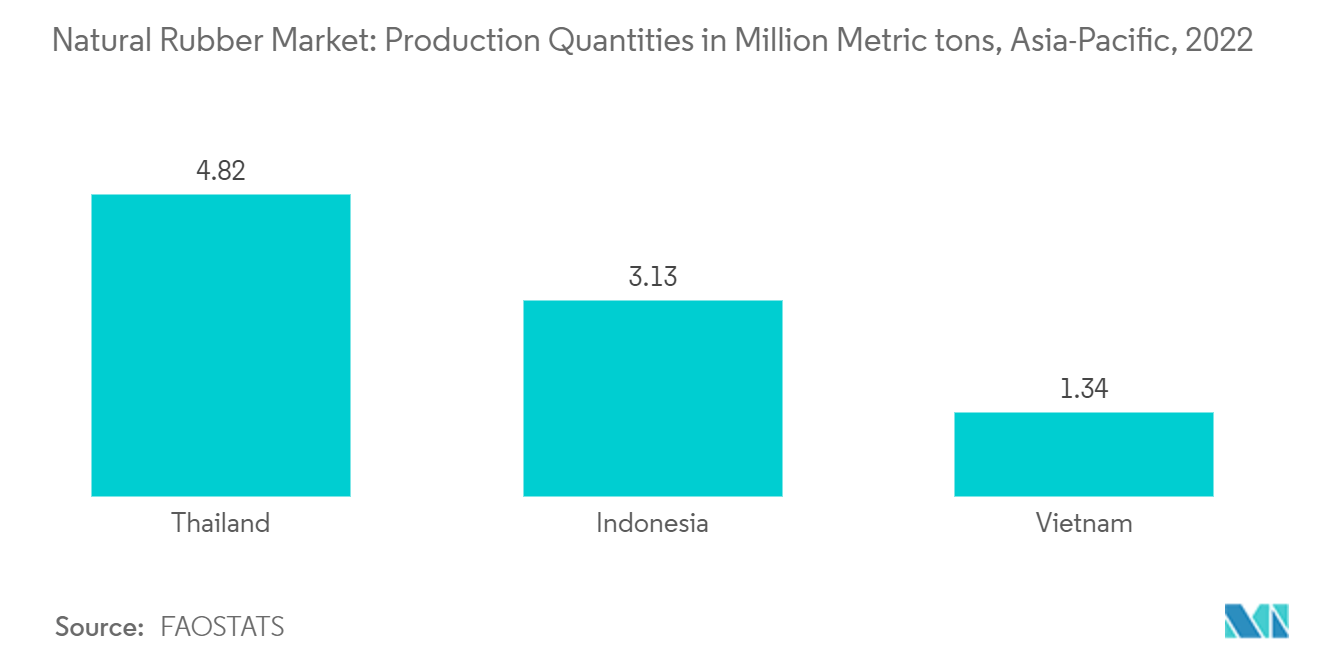Natural Rubber Market Size

| Study Period | 2019 - 2029 |
| Market Size (2024) | USD 18.14 Billion |
| Market Size (2029) | USD 22.82 Billion |
| CAGR (2024 - 2029) | 4.70 % |
| Fastest Growing Market | Asia-Pacific |
| Largest Market | Asia-Pacific |
Major Players*Disclaimer: Major Players sorted in no particular order |
Natural Rubber Market Analysis
The Natural Rubber Market size is estimated at USD 18.14 billion in 2024, and is expected to reach USD 22.82 billion by 2029, growing at a CAGR of 4.70% during the forecast period (2024-2029).
Natural rubber is one of the essential polymers as it is an essential raw material used to create more than 40,000 products. It is used in manufacturing tires, latex products, toys, footwear, and other latex-related products. Natural rubber is preferred over synthetic rubber due to its high tensile strength, vibration-dampening properties, and tear resistance. This makes it important for the construction and automobile industries. The growth of the automobile market across countries is anticipated to increase the demand for natural rubber production. Furthermore, the demand for latex products, such as catheters, gloves, and belts, is also increasing the demand for natural rubber globally.
Asia-Pacific is the largest producer, producing over 90% of the global natural rubber production. According to FAOSTATS, in 2022, the production quantity of natural rubber was 12.8 million metric tons, which increased from 12.5 million metric tons in 2021. Major countries involved in rubber production are Thailand, Vietnam, Indonesia, China, and India.
Besides production, Asia-Pacific is also the world's largest consumer of natural rubber due to the presence of major automobile manufacturing countries such as China, Japan, and India. For instance, China is the world's largest importer and consumer of natural rubber, consuming around 40.0% of the total global output annually. According to the ITC Trademap, India imported 562.1 thousand metric tons of natural rubber in 2022, highlighting a strong demand that outstrips domestic production. Therefore, the rising demand for latex products, coupled with the growing global automobile and construction industry, is one of the major factors anticipated to drive the natural rubber market during the forecast period.
Natural Rubber Market Trends
Increasing Demand from Multiple Industries
The demand for natural rubber is increasing due to its characteristic properties, such as adhesion to metals and resistance to abrasion, which make it suitable for manufacturing seals, tires, etc. The properties of natural rubber, such as high tensile strength, vibration dampening, and tear resistance, make it ideal and more preferred than synthetic rubber for its application in the automobile industry and large constructions. The largest end-user of rubber is the automotive parts industry, which uses a massive amount of rubber to make pipes, gaskets, car tires, hoses, and other parts yearly.
The high growth in developing economies and the increasing per capita income among consumers in these countries increase the demand for automobiles. This, in turn, increases the demand for rubber in these regions. In countries like China, India, Brazil, Indonesia, Malaysia, and Vietnam, the growth of industrial and infrastructure industries is on the rise, which is expected to impact the rubber market positively. According to the ITC trade map, China imported 2.73 million metric tons of natural rubber in 2023.
Natural rubber is used in footwear manufacturing due to its properties, such as durability, slip resistance, and tensile resistance, resulting in increased demand from the footwear industry. The increased applications of natural rubber are increasing the demand for high natural rubber production, which has led to the harvested area of natural rubber globally. According to the FAOSTATS, in 2021, the harvested area of natural rubber globally was 13,420,413 hectares, and in 2022, it reached 13,785,378 hectares. Therefore, the increasing demand from developing countries in line with the increased global production is anticipated to drive the natural rubber market.

Asia-Pacific is Dominating the Market
Natural rubber is a vital agricultural commodity used for manufacturing in various industries, such as automotive, manufacturing, and medical. Thailand, Vietnam, and Indonesia are some of the dominant natural rubber producers. Thailand is the top producer in the world, and the country produced about 4.82 million metric tons of natural rubber in 2022. Around 90% of natural rubber production in Thailand is produced by smallholder farmers, while 10% comes from estates/large-scale holders.
The rubber produced by the smallholder farmers is generally sold as field latex, unsmoked sheets, cup lumps, or crepe blankets, and it is handled by intermediaries, reducing the income of these farmers. Among key consumers, China is one of the major three automobile manufacturers in the world. The increasing growth of the automobile industry resulted in an increased demand for raw materials, such as natural rubber.
Thailand, Vietnam, and Indonesia are some of the major exporters of natural rubber to China. According to the ITC Trademap, over half of China's natural rubber imports come from Thailand. According to the ITC Trademap, Thailand and Indonesia exported 3.28 and 2.04 million metric tons of natural rubber in 2022, respectively.

Natural Rubber Market News
July 2023: Sumitomo Rubber Group launched a risk assessment tool for sustainable natural rubber procurement in Singapore. This tool can cover 10 natural rubber-producing countries, including many procurement areas.
November 2022: The Rubber Industries Smallholders Development Authority (RISDA) allocated USD 111 million for rubber replanting in Malaysia. The fund also aims to improve productivity, marketing, new product initiatives, and entrepreneurship programs to increase rubber production in the country.
October 2022: Bridgestone Corporation expanded its rubber plantations in Southeast Asia with an investment of USD 26.7 million. These investments ensure a sustainable supply of natural rubber for producing tires.
Natural Rubber Market Report - Table of Contents
1. INTRODUCTION
- 1.1 Study Assumptions and Market Definition
- 1.2 Scope of the Study
2. RESEARCH METHODOLOGY
3. EXECUTIVE SUMMARY
4. MARKET DYNAMICS
- 4.1 Market Overview
-
4.2 Market Drivers
- 4.2.1 Increasing Demand from Multiple Industries
- 4.2.2 Growth in Income Levels of Consumers and Products
- 4.2.3 Increasing Demand for Sustainable and Biodegradable Products
-
4.3 Market Restraints
- 4.3.1 Disease and Pests are Affecting Rubber Plants
- 4.3.2 Health Hazards and Environmental Issues Associated with the Rubber Cultivation
- 4.4 Value Chain Analysis
5. MARKET SEGMENTATION
-
5.1 Geography (Production Analysis, Consumption Analysis by Value and Volume, Import Analysis by Value and Volume, and Export Analysis by Value and Volume and Price Trend Analysis)
- 5.1.1 North America
- 5.1.1.1 United States
- 5.1.1.2 Mexico
- 5.1.2 Europe
- 5.1.2.1 Germany
- 5.1.2.2 France
- 5.1.2.3 Italy
- 5.1.2.4 Turkey
- 5.1.3 Asia-Pacific
- 5.1.3.1 China
- 5.1.3.2 Malaysia
- 5.1.3.3 Thailand
- 5.1.3.4 Japan
- 5.1.3.5 India
- 5.1.3.6 Indonesia
- 5.1.4 South America
- 5.1.4.1 Brazil
- 5.1.4.2 Chile
- 5.1.5 Africa
- 5.1.5.1 South Africa
6. MARKET OPPORTUNITIES AND FUTURE TRENDS
** Subject To AvailablityNatural Rubber Industry Segmentation
Natural rubber is an elastic material obtained from the latex sap of trees, like the genera Hevea and Ficus, which can be vulcanized and finished into various products used for daily purposes. The report defines the market in terms of end users who procure natural rubber for various applications.
The rubber market includes production analysis (volume), consumption analysis (value and volume), export analysis (value and volume), import analysis (value and volume), and price trend analysis. The rubber market is segmented by geography into North America, Europe, Asia-Pacific, South America, and Africa.
The report offers the market size and forecasts in terms of volume in metric tons and value in USD for all the above segments.
| Geography (Production Analysis, Consumption Analysis by Value and Volume, Import Analysis by Value and Volume, and Export Analysis by Value and Volume and Price Trend Analysis) | North America | United States |
| Mexico | ||
| Geography (Production Analysis, Consumption Analysis by Value and Volume, Import Analysis by Value and Volume, and Export Analysis by Value and Volume and Price Trend Analysis) | Europe | Germany |
| France | ||
| Italy | ||
| Turkey | ||
| Geography (Production Analysis, Consumption Analysis by Value and Volume, Import Analysis by Value and Volume, and Export Analysis by Value and Volume and Price Trend Analysis) | Asia-Pacific | China |
| Malaysia | ||
| Thailand | ||
| Japan | ||
| India | ||
| Indonesia | ||
| Geography (Production Analysis, Consumption Analysis by Value and Volume, Import Analysis by Value and Volume, and Export Analysis by Value and Volume and Price Trend Analysis) | South America | Brazil |
| Chile | ||
| Geography (Production Analysis, Consumption Analysis by Value and Volume, Import Analysis by Value and Volume, and Export Analysis by Value and Volume and Price Trend Analysis) | Africa | South Africa |
Natural Rubber Market Research FAQs
How big is the Natural Rubber Market?
The Natural Rubber Market size is expected to reach USD 18.14 billion in 2024 and grow at a CAGR of 4.70% to reach USD 22.82 billion by 2029.
What is the current Natural Rubber Market size?
In 2024, the Natural Rubber Market size is expected to reach USD 18.14 billion.
Which is the fastest growing region in Natural Rubber Market?
Asia-Pacific is estimated to grow at the highest CAGR over the forecast period (2024-2029).
Which region has the biggest share in Natural Rubber Market?
In 2024, the Asia-Pacific accounts for the largest market share in Natural Rubber Market.
What years does this Natural Rubber Market cover, and what was the market size in 2023?
In 2023, the Natural Rubber Market size was estimated at USD 17.29 billion. The report covers the Natural Rubber Market historical market size for years: 2019, 2020, 2021, 2022 and 2023. The report also forecasts the Natural Rubber Market size for years: 2024, 2025, 2026, 2027, 2028 and 2029.
What are the emerging technologies impacting natural rubber production?
The emerging technologies impacting Natural Rubber production are a) Advances in tapping technologies b) Genetic engineering for high-yield trees c) Bio-based alternatives
What are the emerging technologies impacting natural rubber production?
The emerging technologies impacting Natural Rubber production are a) Advances in tapping technologies b) Genetic engineering for high-yield trees c) Bio-based alternatives
Natural Rubber Industry Report
The global natural rubber market is a crucial component in various industries, including automotive, consumer goods, manufacturing, and medical sectors, due to its versatile applications and unique material properties. Southeast Asia, particularly countries like Thailand, Indonesia, Vietnam, and Malaysia, dominates production. The market faces competition from synthetic rubber, price volatility, and environmental challenges.
The industry outlook highlights the importance of sustainability and innovation for continued market growth. Detailed industry reports provide comprehensive market analysis, including market size, market trends, and price trends. These reports offer valuable market data, market forecast, and market predictions, ensuring stakeholders are well-informed about the market's dynamics.
The rubber market is segmented into various applications, such as auto-tires, latex products, and footwear. This segmentation reflects the market's adaptability and diverse usage. Despite challenges like counterfeit products and fluctuating prices, the market's growth rate remains promising.
Industry analysis reveals that market leaders are focusing on strategies to mitigate risks and capitalize on emerging opportunities. Industry information and industry statistics are essential for understanding the market's value and segmentation. The market review and market overview provide insights into the current state and future outlook of the market.
For those seeking more detailed information, industry research and report PDFs are available. These documents offer in-depth analysis and industry trends, helping businesses and research companies stay ahead in the competitive landscape. The market's dynamism is further underscored by industry sales and industry size, showcasing its significant economic impact.
In conclusion, the rubber market's outlook is shaped by various factors, including production analysis, consumption analysis, export and import analysis, and price trend analysis. The market's growth is supported by comprehensive industry reports and research, ensuring stakeholders have access to the necessary tools for strategic decision-making.



